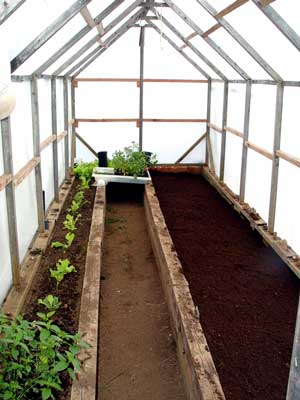Building a Greenhouse
Many do-it-yourself handymen find building a greenhouse to be a fun and rewarding project. Over the years, we have helped advise hundreds of people with their custom greenhouse projects. The most successful endeavors have been those that are carefully thought out and planned. Building a greenhouse does not only take good construction skills, but it is also important to research the best materials to make a strong, efficient, and healthy structure for your plants.
Before beginning construction, you should do plenty of research on how to build a greenhouse. Be sure to speak with other greenhouse gardeners and your local nursery employees to get their input and suggestions, and also consult many of the relevant greenhouse construction and planning books available. Some important points to consider are the best location to build a greenhouse, as well as the greenhouse construction materials and the general greenhouse design you want.
CONSIDER YOUR REGION
When building a greenhouse, you need to ensure that the greenhouse you construct will be adequate for your region. For example, if you often get heavy snow, it is advisable to use materials that are especially strong and durable for your greenhouse. Another concern with wintry weather is heat loss. If you plan to use the greenhouse year-round it will be important to choose insulated framing and insulated greenhouse covering materials that will help hold in the heat.
snow, it is advisable to use materials that are especially strong and durable for your greenhouse. Another concern with wintry weather is heat loss. If you plan to use the greenhouse year-round it will be important to choose insulated framing and insulated greenhouse covering materials that will help hold in the heat.
Many people must also deal with the challenges of windy areas when building a greenhouse. In this case, it is important to choose sturdy greenhouse building materials and design your greenhouse with a shape that will allow wind to pass over the structure. (Rounded styles often work well for high-wind areas.) Once the greenhouse is built, make sure to secure it to the ground or a foundation to ensure it will not blow away.
PREPARING YOUR GREENHOUSE SITE
The location for your new greenhouse should also be chosen with care before you begin building your greenhouse. It will need plenty of sun, although some partial shade may be fine. Southern exposure is best. Orient your greenhouse so it gets as much Southern exposure as possible (for example, if you have an 8'W x 16'L greenhouse, the greenhouse should be oriented East/West so the longest side faces south.) Make sure that you will be able to run electricity and water to the greenhouse to power heaters and fans and water your plants.
Once you have found the perfect location, you will need to prepare the ground. We recommend that you simply level the ground and then pour a few inches of gravel over the dirt where you want to put the greenhouse. This allows for much better drainage, which helps to keep the greenhouse clean and disease-free. It also makes it possible to easily move the greenhouse if necessary and is much less expensive than pouring a concrete foundation.
GREENHOUSE FRAMING AND COVERING
In order to ensure that you build a greenhouse that is as functional as possible, you need to carefully research greenhouse framing and covering materials. Decide if you want a rigid more permanent covering or something that is inexpensive and easy to replace. ( Read more about Greenhouse Covering here). Once you have decided which covering you will use on your greenhouse, you will have a better idea of what type of framing is best suited to support the greenhouse covering. With more rigid coverings, you should provide supports for the greenhouse covering material approximately every two feet. Some greenhouse coverings need to be built into the frame via channels while others are just simply set on top of the framing and attached with screws. As you consider how you will apply the covering material, also plan for vents. You will need at least one large vent to allow proper air flow, but you should also add base vents and fans for optimal ventilation. Read more about ventilation.
One advantage of building a greenhouse yourself is that you can configure the inside to best fit your growing needs. Left over greenhouse framing material can be used to create a basic bench frame structure for the shelving. It is best that you use shelving made with some kind of wire instead of a solid material. This allows for better drainage and also permits necessary fresh air to flow to the roots of your greenhouse plants. Also make sure the shelving material is strong enough to hold your heavy plants and allow room for both small and tall plants. For extra space, it may be possible to add hanging rods if your greenhouse framing material is strong enough to support the weight.
TIP: Make economical bench tops using 3 slats of wood (4x1's work well, cut to the length of the bench frame) and chicken wire. Spread the wood so a piece sits on the front, middle and back of the bench frame. Lay the chicken wire over the top and cut to fit. Attach it to the wood with a staple gun or nails.
With all of this said, it is important to make one more important note about building a greenhouse. Once you have figured out the time and costs involved, it is a good idea to compare that amount with the cost of a pre-fabricated greenhouse kit. After considering the cost of the materials when purchased individually as well as extra materials for errors, you may actually spend less money and be more satisfied purchasing a greenhouse kit than building a greenhouse yourself. Even if you think that you will still end up building a greenhouse, we highly recommend looking into the greenhouse kits available. You may be surprised to find one that will work well for you and, if nothing else, these greenhouse kits will give you further ideas about building a greenhouse of your own.
Greenhouse covering materials





